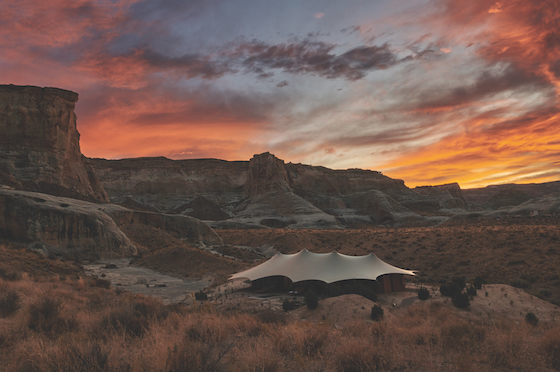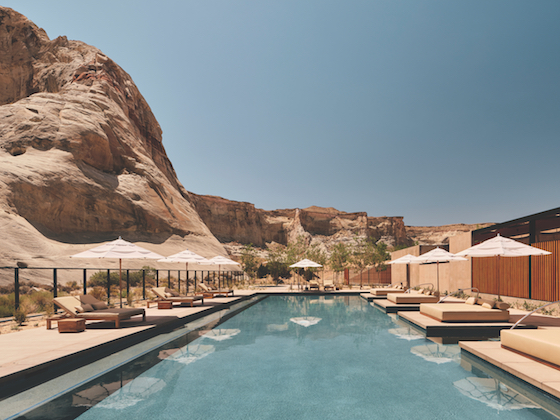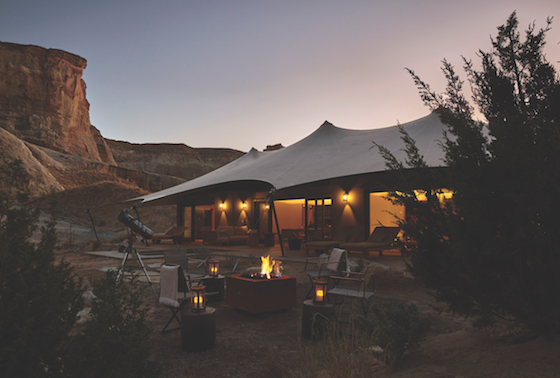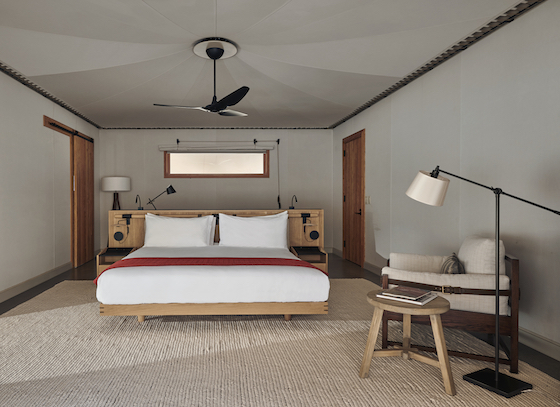While the opening of a new hotel is always cause for celebration, during this era of COVID-19 recovery it’s a vote of confidence that travelin’ days are here again — or will be, soon.
Camp Sarika, the long-awaited sibling of developer Canyon Equity’s Amangiri Resort in Canyon Point, Utah, makes a virtue of social distancing. The rugged, 78-acre desert site is billed as the first all-weather, year-round luxury camp in North America. With 10 “pavilion” tents and a brick-and-mortar building for the lobby, spa and restaurant, the sprawling destination is surrounded by 600 acres of wilderness and framed by 165-million-year-old sandstone formations.
The camp opened on July 1, three months later than originally planned. “Amangiri and Camp Sarika’s protocols exceed those mandated by Utah and the CDC,” says Homi Vazifdar, CEO of Larkspur, California-based Canyon Equity, “but at the same time, our guests are pretty uber-wealthy, so we needed to create an environment that doesn’t look clinical or make them uncomfortable.”

Contributed by Alicia Sheber
Occupancy started at 50% with altered SOPs for social distancing, Vazifdar says. “We’ve been inundated with requests and have a waiting list,” he says. Because of the inherent social distancing in Camp Sarika’s masterplan, all 10 tents can be occupied without structural or?layout changes driven by COVID-19.
Blending with sandstone
Located a 30-minute hike or a five-minute drive from Amangiri, Camp Sarika comprises five 1,900-square-foot one-bedroom tents and five 2,800-square-foot versions with two bedrooms, designed by Luxury Frontiers, based in San Francisco and Johannesburg. Each tent includes living and dining areas; wet and dry bars; bathrooms with tub; indoor and outdoor showers; heated plunge pool; firepit; and a deck shaded by an extended canvas overhang.
Graeme Labe, Luxury Frontiers’ principal and managing director, says developing tents that can be used year-round in Utah’s weather extremes was a meticulous process of repeated trials with computer-generated simulation models. Finding compatibility with Utah building codes was also a hurdle for a project aspiring to be highly considerate of its surroundings, he says. Construction materials, methodologies and indigenous plantings were chosen for their minimal impact and ability to blend almost invisibly with the sandstone mesas.
With the Navajo Nation Reservation situated alongside Amagiri, Luxury Frontiers’ initial inclination was to honor Native American culture by designing luxury tepees for Camp Sarika. However, research revealed that Navajo tribes don’t build tepees, says Labe.

“Their traditional housing is called a hogan, a structure made from sticks and branches that are covered with animal skins and then rocks or stones,” he says. Because these dwellings feel more like caves, replicating them would create a visual barrier to viewing the expansive panorama. The team opted to build tents that allow maximum immersion into the environment without sacrificing comfort.
Each pavilion is formed from inner and outer coverings stretched across a timber frame with concrete as a foundation. The fabric for the exterior tent and overhangs is a UV-rated, high-tensile PVC membrane that can withstand 115 mph wind gusts and two feet of snow. The tent fabric is created within a closed-loop system, using recycled content that can be returned for recycling.

Insulation sandwiched between the two tents, as well as each pavilion’s independent HVAC system, regulates temperature extremes. Applying the principles of ancient Bedouin tents, the interiors are divided into “rooms” with windows onto the landscape, even in the bathroom. All tents are oriented towards a mesa, a grounding effect so that guests don’t feel adrift in the desert. With nature the star of the show, ornamentation is nearly nil: a striped cushion, a belt buckle and a headboard etched with a scene inspired by the landscape.
Clean and modernist
New York-based Selldorf Architects conceived Camp Sarika’s clean-lined lobby, spa and restaurant building in the modernist spirit of the Amangiri resort, which opened in 2009. Maya Lin, architect and sculptor of the Vietnam War Memorial in Washington, D.C., created the camp lobby’s glass and marble sculpture, Wahweap, inspired by the flow of water from nearby Lake Powell to Lake Mead.
“The luxury market is gravitating towards experiential hospitality,” Vazifdar says. “In the Americas, there’s a big hole in the market for not just tents, but super-?luxury tree houses and lodges like the ones in Africa, India and Southeast Asia.”
With plans to develop more tented destinations in canyon regions, wine country, and state and national parks, it seems Canyon Equity would agree.

